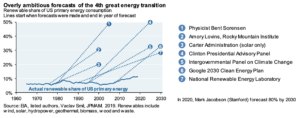The JP Morgan Asset and Wealth Management Annual Energy Paper is one of the most influential publications among global investment and business leaders in the energy sector.
But JP Morgan Chase’s 2021 Annual Energy Paper is a deeply flawed piece of work that promotes some serious misinformation about the clean energy transformation, reinforcing the mistaken belief – often promulgated by fossil fuel companies – that it will be slow, expensive and require onerous state intervention.
Coming from JP Morgan Chase – the world’s fifth largest bank, and the largest lender to fossil fuel industries – the paper informs the policy, investment and business decisions of many influential companies, organisations and governments around the world. Which is why it is important to understand that the world’s largest fossil fuel lender appears largely oblivious to the dynamics of technology disruptions and energy transitions.
Myth 1: Renewable energy forecasts are too optimistic
The Annual Energy Paper, authored by chairman of JP Morgan Asset Management’s chairman of market and investment strategy Michael Cembalest, was overseen by its technical advisor, influential academic Vaclav Smil.
Its tone is set by a graph on the first page depicting alleged failed ‘renewable energy forecasts’. The graph seems to show that these forecasts were overly optimistic, and then repeatedly turned out to be false.

Yet according to Ketan Joshi, who previously worked in science communications for Australia’s national science agency, the sources for the alleged forecasts are impossible to trace.
For instance, he writes: “Danish physicist Bent Sørensen, for instance, seems to have published the figure between 1978 and 1980, and it isn’t easy to figure out where the prediction of 50% by 2000 was made. There was never any ‘Clinton Presidential Advisory Panel’ – the phrase can only be found in republications of this very chart; so that’s a mystery.”
…click on the above link to read the rest of the article…
